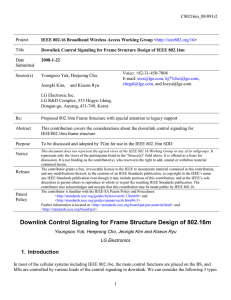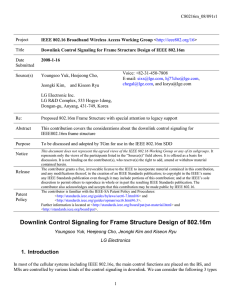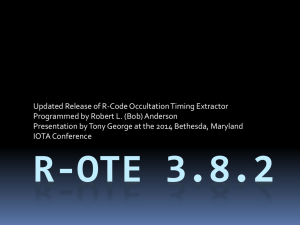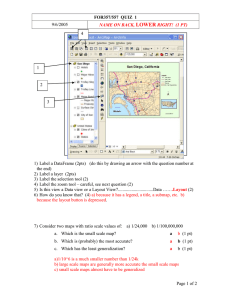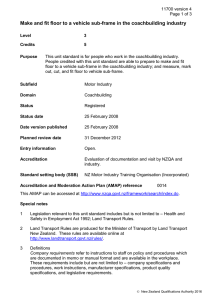C80216m_08/xxx Project Title
advertisement
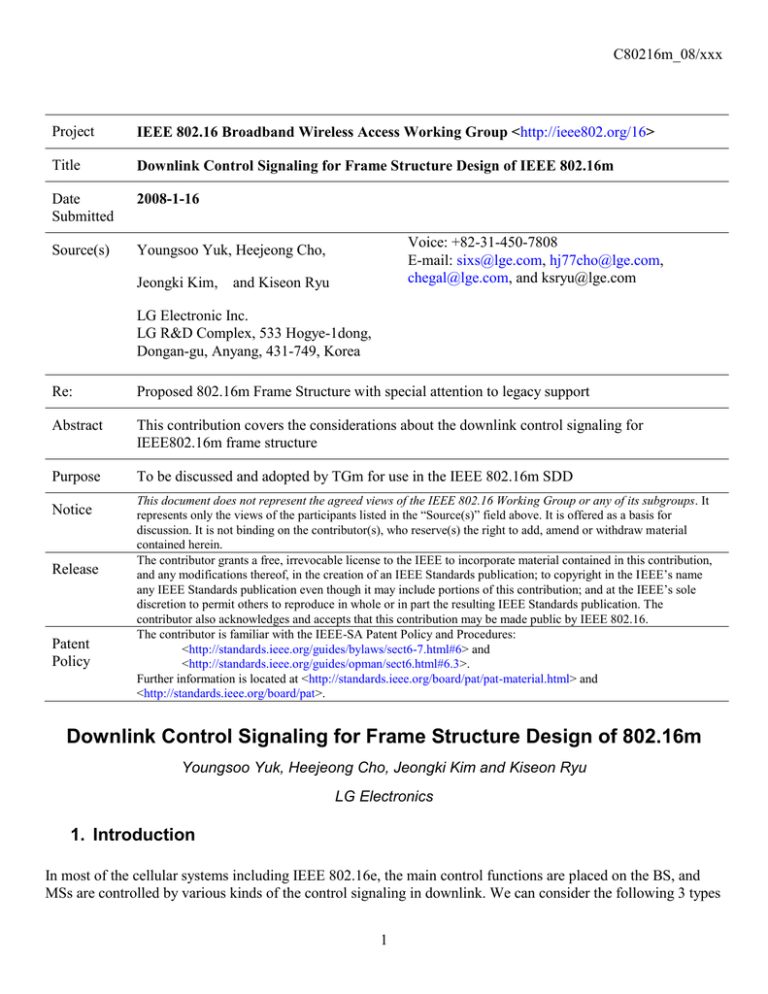
C80216m_08/xxx Project IEEE 802.16 Broadband Wireless Access Working Group <http://ieee802.org/16> Title Downlink Control Signaling for Frame Structure Design of IEEE 802.16m Date Submitted 2008-1-16 Source(s) Youngsoo Yuk, Heejeong Cho, Jeongki Kim, Voice: +82-31-450-7808 E-mail: sixs@lge.com, hj77cho@lge.com, chegal@lge.com, and ksryu@lge.com and Kiseon Ryu LG Electronic Inc. LG R&D Complex, 533 Hogye-1dong, Dongan-gu, Anyang, 431-749, Korea Re: Proposed 802.16m Frame Structure with special attention to legacy support Abstract This contribution covers the considerations about the downlink control signaling for IEEE802.16m frame structure Purpose To be discussed and adopted by TGm for use in the IEEE 802.16m SDD Notice Release Patent Policy This document does not represent the agreed views of the IEEE 802.16 Working Group or any of its subgroups. It represents only the views of the participants listed in the “Source(s)” field above. It is offered as a basis for discussion. It is not binding on the contributor(s), who reserve(s) the right to add, amend or withdraw material contained herein. The contributor grants a free, irrevocable license to the IEEE to incorporate material contained in this contribution, and any modifications thereof, in the creation of an IEEE Standards publication; to copyright in the IEEE’s name any IEEE Standards publication even though it may include portions of this contribution; and at the IEEE’s sole discretion to permit others to reproduce in whole or in part the resulting IEEE Standards publication. The contributor also acknowledges and accepts that this contribution may be made public by IEEE 802.16. The contributor is familiar with the IEEE-SA Patent Policy and Procedures: <http://standards.ieee.org/guides/bylaws/sect6-7.html#6> and <http://standards.ieee.org/guides/opman/sect6.html#6.3>. Further information is located at <http://standards.ieee.org/board/pat/pat-material.html> and <http://standards.ieee.org/board/pat>. Downlink Control Signaling for Frame Structure Design of 802.16m Youngsoo Yuk, Heejeong Cho, Jeongki Kim and Kiseon Ryu LG Electronics 1. Introduction In most of the cellular systems including IEEE 802.16e, the main control functions are placed on the BS, and MSs are controlled by various kinds of the control signaling in downlink. We can consider the following 3 types 1 C80216m_08/xxx of downlink control. - System Information - Management Messages - DL/UL Scheduling Above two are on the procedures about the system, and the others are on link procedures. To meet the system requirements of IEEE 802.16m, the introduction of the shorter frame size and the lowlatency signaling also can be considered [1]. From this point of view, we discuss the various considerations of the downlink control channels design in this contribution. In case of the management messages, they are used to transmit by the in-band signaling and it has been considered as a appropriate method. Thus, in this contribution, our main discussions are focused to the system information and the scheduling signaling. 2. Broadcasting of System Information During the initial entry procedure, MS may try to obtain the various kinds of the system information about the BS and the cellular system. The system information may contain the BS ID, downlink frame configuration, paging information, ranging channel information and so on. After acquiring of the system information, MS can try to make a connection with the BS for receiving service. Thus the interval for transmitting the system information is the key factor to have impact on the delay of the initial entry procedure of the systems. The system information broadcasting in the IEEE 802.16e is performed by DCD/UCD messages, and it has with the maximum interval of 10s, which is too long. Though it can be transmitted more frequently, it requires extra radio resource for duplicated transmission. Furthemore to know which frame have the DCD or UCD messages, MS needs to decode every DL MAP for finding the location of DCD or UCD. In case that some values of these channel descriptors in DCD/UCD messages change, the channel descriptors including unchanged fields as well as changed fields are transmitted at next interval by the BS. Since only one DCD/UCD message contains the required system information and its regular transmission interval is long, the update of the whole set of channel descriptors for SS or MS can be considerably delayed. For the purpose of fast initial entry procedure and flexible update of channel descriptors, more efficient transmission scheme of system information broadcasting method should be considered. To minimize the initial entry procedure time, transition delay of channel descriptors and to update changed channel descriptors efficiently, a variety of system information should be categorized according to the changing rate of fields of channel descriptors and necessary information at the early stage for initial entry procedure or not. And besides the transmission interval for the frequently changed and essential system information should be sufficiently short. However, the shorter the interval of that information is, the more the spectrum usage for the control information increases. We can also consider the use of the multiple DCDs and UCDs for the efficient transmission of the system information. We define them as sub-DCD/UCD for convenience throughout this document. Each subDCD/UCD contains a group of system information, and their transmission time is scheduled by BS. By applying different transmission periods to each sub-DCD/UCD, a more flexible system control is manageable for BS. 2 C80216m_08/xxx 3. 802.16m Scheduling Control Enhancement based on Hierarchical MAP Broadcast vs Dedicated Channel The existing IEEE 802.16e has simple scheduling method by using the Frame MAP architecture. Various kinds of scheduling information can be signaled by forms of MAP IE (Information Elements). Originally, MAP is broadcasted to the whole cell area, hence it is good to transmit the common/broadcast control messages. However, it requires high spectrum usage for guaranteeing the reliable transmission of the information to the MS in the cell edge area as well as minimizing the inter-cell interference. Thus MAP should be transmitted with very powerful channel coding such as CTC combined with the repetition coding instead of using the high power. To overcome this limitation, the combination of the compressed DL MAP with SUB-DL-UL-MAP is more practically used now. The SUB-DL-UL MAP has a role of a scheduling for the group of some CIDs which have the same or similar MCS levels. Both the broadcast information and the dedicated control information can be transmitted by MAP, however, the common use of two different control information does not seem to be a proper solution for the efficient spectrum usages. Table 1 shows the system level simulation result of the average distribution of the preferred MCS levels selected by multiple MSs in 802.16e cells. The target FER is set to 1%, and CTC size of 480 bits is used. Though, the use of CC seems to be more reasonable for the control signaling, we can see the basic tendency of the great efficiency of the dedicated control channel by use of this result. In 802.16e, basically maximum 3 SUB-DL-UL-MAP can be used in a frame, so that maximum 3 MCS levels can be used to encode the MAP. To get more spectral efficiency, more various MCS levels should be used for the MAP encoding simultaneously. Table 2 shows the average number of the required subcarriers to transmit 1 bit control information. We found the best case of the MCS set among various MCS sets in the point of the required subcarriers, and applied it to the below analysis. Table 1. The system simulation results of the selected MCS distribution for 1% FER QPSK 1/12 MCS Level The ratio of the MS selects that MCS (A) Required carriers for 1 Bit transmission (B) QPSK 1/8 QPSK 1/4 QPSK 1/2 QPSK 3/4 16QAM 16QAM 64QAM 64QAM 64QAM 1/2 3/4 2/3 3/4 5/6 7.1E-6 6.2E-4 0.029 0.212 0.081 0.272 0.204 0.056 0.082 0.062 6 4 2 1 2/3 0.5 1/3 0.25 1/3 0.2 Table 2. The average number of the required subcarriers for 1 bit transmission with the different number of the MCS levels (Assuming the CTC with size of 480) Size of MCS Set Average number of required subcarriers for 1 bit transmission (Nsc(M)) Relative spectral gain from one level addition (%) (Nsc(M-1)/Nsc(M) -1) 1 6 NA QPSK 1/12 2 1.147 423% QPSK 1/12, QPSK1/2 3 0.809 42% QPSK 1/12, QPSK1/2, 16QAM1/2 (M) Elements of used MCS set (Best Case chosen from Table 1) 3 Remarks 16e Maximum C80216m_08/xxx 4 0.692 17% QPSK 1/12, QPSK1/4,QPSK1/2, 16QAM1/2 5 0.625 11% QPSK 1/12, QPSK1/4,QPSK1/2, 16QAM1/2, 16QAM3/4, 6 0.598 4.6% QPSK 1/12, QPSK1/4,QPSK1/2, QPSK3/4, 16QAM1/2, 16QAM3/4 7 0.581 2.9% QPSK 1/12, QPSK1/4,QPSK1/2, QPSK3/4, 16QAM1/2, 16QAM3/4, 64QAM2/3 8 0.578 0.5% QPSK 1/12, QPSK1/4,QPSK1/2, QPSK3/4, 16QAM1/2, 16QAM3/4, 64QAM2/3, 64QAM3/4 9 0.576 0.3% QPSK 1/12, QPSK1/4,QPSK1/2, QPSK3/4, 16QAM1/2, 16QAM3/4, 64QAM2/3, 64QAM3/4, 64QAM5/6 10 0.575 0.2% QPSK 1/12, QPSK1/8,QPSK1/4,QPSK1/2, QPSK3/4, 16QAM1/2, 16QAM3/4, 64QAM2/3, 64QAM3/4, 64QAM5/6 Require 2bits for MCS indication 16QAM Require 3bits for MCS indication The spectrum efficiency gain by using the dedicated control channel is very high, more than 10 times than the case of the only use of the broadcast control (The case only use the QPSK 1/12). Even if we consider the comparison with the result of the case with 3 MCSs, as the number of the MCS levels increases, the efficiency also increases by maximum 17%. To enhance the system efficiency, more active use of the dedicated control channel is required. In addition, the effort for minimizing the common messages which should be transmitted through the broadcast channel may be required. Overhead Analysis with the Shorter Frame Size For achieving the 802.16m latency requirements, the introduction of the shorter sized frame is required. In addition, for the low-latency scheduling, the frame size in the 16m system would become shorter than 5ms. To realize this concept, it is easy to introduce a sub-frame by dividing the existing frame. As a matter of fact, the sub-frame concept is more efficient applied to the FDD system, however, it also gives a latency gain to the TDD system[3]. Though the shorter frame size can give a latency gain, however, the control overhead may be increase. However, if the active use of the dedicated control can mitigate this overhead increase problem. Followings are the analysis result for this effect. For fair overhead comparisons between the legacy system and the 802.16m system with the shorter frame size, we assume essential control signal based on the legacy system and compare sub-frame configuration options to each other. The basic assumptions can be summarized as follows: Legacy MAP Configuration (for one frame) - One Compressed DL MAP - Two STC Zone IE - One HARQ MAP Pointer IE for each SUB-DL-UL-MAP - 3 SUB DL-UL MAP/frame Shorter-sized MAP Configuration (for one frame) 4 C80216m_08/xxx - One Compressed DL MAP/frame : Frame Configuration info - Two STC Zone IE/frame - One HARQ MAP Pointer IE for each SUB-DL-UL-MAP - 1 SUB DL-UL MAP /sub-frame ( Case1 ) - Max 3 SUB DL-UL MAP/sub-frame ( Case2 ) Burst Configuration - 12 Bursts per frame with 3 sub-bursts per DL burst - 6 Bursts per frame with 3 sub-bursts per UL burst Modulation and coding - Common control : QPSK and 1/12 (1/2 mother code and 6 repetition) - Dedicated control : MCS sets shown in Table 2 according to the maximum number of SUB-DL-ULMAPs We consider the two cases (Case1 and Case 2) for the 802.16m system according to the maximum number of the SUB-DL-UL MAP in a sub-frame. The number of SUB-DL-UL-MAP is set to one per sub-frame (Case 1) in 16m systems, and is set to 3 per frame in the legacy system. For the worst case comparison, we also consider the “Case 2” with maximum 3 SUB-DL-UL-MAPs per sub-frame. We assume that the common control should be encoded by QPSK 1/12 coding, so that the required subcarriers for 1 byte transmission for common control is determined to 48 (8 * 6), however in case of dedicated control, we assume different modulation and coding schemes based on a MCS set in Table 2, and the required subcarriers are calculated by in Table 2. Therefore, the dedicated control overhead can be reduced for MSs located near a BS. The main effect of the shorter sub-frame on the overhead is the increase of the SUB-DL-UL-MAP. On the other hand, the increase of the SUB-DL-UL-MAP gives the opportunity to use multiple MCS levels for SUB-DL-ULMAP encoding. As shown in Table 2, more active use of multiple MCS provides more spectral gain. Considering two factors, we have calculated the total number of the required subcarriers/cell/frame with multiple options, and they are shown in Table 3~Table 6. As shown in the tables, as the number of the sub-frames increases, the total overhead (bytes) also increases. However, by applying the multiple MCS level to the dedicated part of the overhead, the average required radio resource (Number of subcarriers) decreases. In addition, by using simple MAP optimization (change the bits assign to symbol offset and the number of the symbol per burst according to the short frame size) more gains can be achieved. The results say the requirement of the active use of the dedicated channels for downlink control. In addition, additional optimization on the sub-frame control should be required. And, the use of 16QAM for the control channel also should be considered for higher spectral efficiency gain. Table 3. Frame Configuration according to subframe size (N_Symbols/subframe, N_subframe/frame) Subframe Size (symbol) N_Subframes/Frame N_DL Subframes Legacy (12,4) (8,6) (6,8) (4,12) (3,16) None 2 1 12 4 3 8 6 4 6 8 5 4 12 8 3 16 10 N_UL Subframes 1 1 2 3 4 6 N_SUB_MAP (Case1) N_SUB_MAP (Case2) 3 3 3 9 4 12 5 12 8 12 10 12 5 C80216m_08/xxx Table 4. Control Overhead for Case 1 Common Overhead Dedicated Overhead Total Overhead (bytes) Average number of required subcarriers per the frame Legacy 30 429 459 (12,4) 30 429 459 (8,6) 32 436 468 (6,8) 34 440 474 (4,12) 40 456 496 (3,16) 44 468 512 4216 4216 3718 3741 4028 4269 Table 5. Control Overhead for Case 1 ( with simple MAP optimization of symbol offset and number) Common Overhead Dedicated Overhead Total Overhead (bytes) Average number of required subcarriers per the frame Legacy 30 429 459 (12,4) 30 420 450 (8,6) 32 422 454 (6,8) 34 425 459 (4,12) 40 432 472 (3,16) 44 440 484 4216 4158 3648 3669 3917 4140 Table 6. Control Overhead for Case 2 Common Overhead Dedicated Overhead Total Overhead (bytes) Average number of required subcarriers per the frame Legacy 30 429 459 (12,4) 42 462 504 (8,6) 48 480 528 (6,8) 48 480 528 (4,12) 48 480 528 (3,16) 48 480 528 4216 4145 4516 4516 4516 4516 Hierarchical MAP Structure for supporting Shorter Frame Size Two methods can be considered for the control channel design. One is the use of a new single MAP with the dedicated channel only, and the other is the use of the hierarchical MAP structure. The former may be efficient for fast signaling by reducing the message referencing steps. However, about the common information, the duplicated transmission may make a waste of the spectrum. Moreover, for the indication of each control channel, an additional indicator channel should be transmitted. In addition, to reduce the indication overhead, the flexibility of the scheduling channel may be limited. The basic concept of the hierarchical MAP is started from dividing the scheduling signal into the common part and the dedicated part. Each part should be mapped to the more efficient physical channels, the broadcast channels for the common part and the dedicated channels for the dedicated part. Thus the use of the hierarchical MAP seems to be more proper solution for the spectrum efficiency. As a matter of fact, the hierarchical MAP is not a new concept. The co-use of the DL Compressed MAP and the SUB-DL/UL-MAP can be viewed as an example of a Hierarchical MAP. The difference is the introduction of the shorter-sized frame, “sub-frame”. Thus, our next discussion will be going on the efficient hierarchical MAP structure with the basic assumption of the use of the sub-frame. Figure 1 shows the basic concept of an example of a Hierarchical MAP structure. We assume that shorter sized frame (sub-frame) is used for 802.16m system. For the convenience, we call the higher-layer MAP as SuperMAP, and the lower-layer MAP as SubMAP. 6 C80216m_08/xxx The main role of the SuperMAP is to transmit the common control information, such as the system configuration and BS system information and so on. SuperMAP should be encoded enough to support whole cell coverage with powerful encoding scheme. On the other hand, SubMAP may be optimized to each MS by using the dedicated control channel. The SubMAP would play the main scheduling role in the 802.16m system. 16e Functionalities DCD UCD System Information 16m-only Entity 1 6m DCD/UCD 16m Functionalities New System Information Scheduling SuperMAP Frame DL-MAP Configuration Info UL-MAP Scheduling Info System Configuration Information Configuration SubMAP 1 6m Scheduling Info Figure 1. Functional transition of the Hierarchical MAP structure As the SuperMAP does not have main scheduling information, it is not necessary to transmit the SuperMAP at every frame. The period of the SuperMAP can be determined by the operator requirement with the trade off between the overhead and the system flexibility. In the large cell (or if the number of MSs in the cell is sufficiently large), the resource usage may have a special tendency with a steady-state MS and service distribution within a longer time interval than a frame. Thus the sub-frame configuration for a specific period can be maintained without any change. As a result, we can introduce a new fixed period longer than frame, “Superframe”. Considering the flexibility and the overhead, about 4 or 8 frames can be candidates as a Superframe length. With the longer Superframe, as the transmission bits of the common control information is reduced, we can acquire the spectral efficiency gain. On the other hand, with the shorter Superframe, we can acquire the flexibility gain and the latency gain. This period can be determined as an operator’s choice according to its trade-off between the overhead and the flexibility. In this case, the period or the existence should be signaled by a fixed channel such as a new FCH or a new preamble. The following elements can be considered to be included in the SuperMAP and the SubMAP, respectively. The SubMAP would be a dedicated channel for each CID or a burst, and the CID can be dedicated or be multicast. The SubMAP can be power-controlled with the fixed MCS format, or can be rate-controlled by using several MCS format or can be controlled by both manners. 7 C80216m_08/xxx Table 7. The example of the scheduling elements for the Hierarchical MAP SuperMAP (Control Information) Basic System Information System Frame Number BS Reference Signal Power [BS Status Information] [Frame Configuration : DL/UL ratio, TTG, RTG, N_OFDMA Symbols] [Multiple Bandwidth info] etc System Configuration Resource Allocation Info SubMAP Info UL Control Channel Configuration Information Etc Etc SubMAP (Scheduling Information) Channel Type Info DL/ UL MIMO/SIMO/Collaborated MIMO Scheduing/Power Control only Etc [CID or Scheduling ID] Resource Allocation Transmit Format info Transmit MCS level MIMO information HARQ info HARQ Process ID New/Re indicator CC or IR/ RV info [UL Power Control Info] [CQI Channel Info] [ACK/NACK for UL Burst] Etc 4. Physical Channel Structure related to Frame Structure SubMAP location in the Frame Structure The most important factor of the physical channel structure is the resource allocation method. The major properties of the existing MAP channel are the variable size, the fixed location and the whole coverage over the cell area. The variable size gives more flexibility to the control, on contrast it gives the redundancy and decoding delay. In contrast, the fixed location property helps to reduce the indication overhead, but limits to flexible resource allocation. The shorter frame size implies the small number of the resource unit. Thus we should optimize the size of the MAP overhead. Hence, for the efficient use of the sub-frame, we should take more considerations of the overhead than the flexibility in our design. The most ideal method for reducing the overhead is to increase the fixed structure, size, MCS, location and so forth. For minimizing the MAP decoding latency, it is good to locate prior to the data burst. We can consider two possibilities for the SubMAP allocation methods; One is the full span mapping in symbol domain (Figure 2 (a)), and the other is the partial span mapping (Figure 2 (b)). The first method is to divide a sub-frame with a MAP region and a data burst region by OFDMA symbol. The symbol-based dividing can give simpler indication methodology. With this method, the overhead for the MAP indication can be reduced for its fixed structure. Moreover, it can be easily applied to the sub-frame that contains the localized subchannels, by applying the distributed subchannel to the MAP region only. Considering the system efficiency, one symbol per sub-frame can be applied to the SubMAP with a fixed format. In the other hand, as the some amount of symbols to support maximum control information should be allocated as the MAP region, it can make a waste of the resource for this reserved resource not being used. 8 C80216m_08/xxx SubMAP for subframe SubMAP for subframe As the symbol is more large allocation unit than subchannel, thus we can consider the sub-channel based SubMAP mapping with the flexible use of the sub-channel. The method provides higher spectral efficiency however, the information of the SubMAP length should be informed by another channel, such as SubMAP header. In addition, additional MAP resource allocation format should be determined in order to be implemented in a sub-frame having the localized subchannel. Thus our preference is the hybrid use of two methods according to the existence of the distributed subchannels. In case that only the localized channels exist, then the symbol-based mapping may be applied, and in other case, subchannel-based mapping is applied. Data Bursts (a) Full span in symbol-domain Data Bursts (b) Partial span in symbol domain Figure 2. SubMAP Allocation Methods About the location of the SubMAP for the UL sub-frame, its location can be designed with the fixed sub-frame offset ahead to the corresponding UL sub-frame. The offset should be decided with accounting for the decoding and encoding delay. In addition, for reducing the UL scheduling delay for the next packet, the location should be determined with the consideration of the time between the ranging channel and the next UL SubMAP location. In the existing 802.16e system, the UL MAP is not valid until the next frame. The scheduling timing offset is longer than 5ms and is practically about 7ms, which is too long. The timing offset should be lager than the time which consists of the decoding, the encoding time and 2 timing advances. To reach the goal of our 802.16m requirements, we should reduce the processing time under 2ms. It is a practical consideration for the design of the SubMAP location. The fixed relative offset can be applied to indicating the position, and this value can be informed by the SuperMAP or DCD/UCD. It also can be fixed by the specification or the profiling. Another positioning method is to be carried on with the help of the SuperMAP or Legacy MAP which indicates the starting position and/or the length of the SubMAP. This method is basically same concept with the current Compressed MAP/ SUB-DL/UL MAP pair. This method increases not the MAP flexibility but also the control overhead. Figure 3 shows the example of the frame structure based on our discussion. For the different case of the DL/UL configuration, the sub-frame offset between the UL data sub-frame and the corresponding UL sub-frame control can be informed by the SuperMAP or by the DCD/UCD. 9 C80216m_08/xxx SF#0 SF#1 SF#2 SF#3 SF#4 SF#5 SF#6 Preamble Superframe Control DL Subframe Control UL Subframe Control SF#7 DL ACK/NACK The Location of the UL subframe control in the DL Subframes (In case of the fixed subframe offset of 4) ≈2ms ( 2 timing advance + MAP Decoding Time + UL burst Encoding Time) Figure 3 Example of the relation of the location between Downlink Control and DL/UL sub-frame SuperMAP Location SF#1 SF#2 (a) Frame structure with SuperMAP SF#0 SubMAP SubMAP SubMAP 16m Preamble SubMAP SubMAP SubMAP SF#0 SuperMAP 16m Preamble Though the SuperMAP is a higher-level MAP, for maintaining the commonality and supporting the flexible use of the message, the SuperMAP should be located in the burst area of the sub-frame. Without consideration of the legacy-support mode, the position and the MCS level of the SuperMAP may be indicated by the SubMAP by using the broadcast CID. SF#1 SF#2 (b) Frame structure without SuperMAP Figure 4. SuperMAP Position in the legacy disabled mode In the legacy-support mode, there can be two kinds of method could be considered. One possibility of the informing method is to use the legacy DL-MAP, and the SuperMAP can be inserted as a new MAP IE (Figure 5(a)) . Though this method has an advantage for easy shifting from 16e to 16m, the decoding of the legacy MAP is a burden for 16m MSs. It is very useful for the 16m MS for minimizing the power consumption that to know the existence of the 16m SuperMAP without decoding of the legacy MAP. Thus, the indication of the existence of the SuperMAP can be used by the reserved bit of the legacy FCH. In addition, in this case, a new preamble support both the 16e and 16m requirement should be applied. We can also consider the case of the 16m only structure is applied. For this scheme, the different time zone should be mapped for 16e and 16m (Figure 5 (c)). The time zone mapping method can support good migration path, on the other hand, it has a little limitations in the point of view of the zone dividing. 1 0 C80216m_08/xxx SF#1 SubMAP Legacy Zone 16m Preamble SuperMAP SubMAP Preamble SF#2 Legacy MAP SF#1 (Legacy Zone) SubMAP SuperMAP IE Preamble Legacy MAP FCH FCH In these various possibilities, though the structure of the SuperMAP may be changed according to the case of the legacy-support mode or the legacy-disabled mode, the structure of the SubMAP would not be influenced by that change. This is the other advantages of the Hierarchical MAP structure. SF#2 16m Zone (b) TDM Zone Mapping with a new 16m structure (a) Indicated by Legacy MAP as a New MAP IE Figure 5. SuperMAP Position in the legacy support mode MAP Structure About the channel structure, the main issue is to find the optimal point in the point of view of the trade-off between the decoding latency and the size of the overhead. In addition, the coverage and the control efficiency trade-off is also main considerations. In the point of the SuperMAP, the coverage and the overhead are more important factors. Thus the existing legacy MAP structure is sufficient for the SuperMAP to support the whole cell coverage. About the SubMAP structure, we can consider the 3 metrics, and they are the amount of the overheads, the decoding complexity and the spectral efficiency comes from the dedicated coding. The important design parameters determining the metrics are as follows. Encoding Unit SubMAP Indication Method : Existence, Length, Location etc MCS of the SubMAP Indication Method Channel Coding Type The basic encoding unit has influence on the spectral efficiency and the overhead. Thus a burst or a MS should be a encoding unit for the higher spectral efficiency. For the MAP indication, the additional channel with the fixed format is required. This is similar concept with the FCH in the 16e MAP. In case of the per-MS encoding, we can apply the blind detection method with the MS-id masked CRC. This method is well known method for identifying the channel in a shared channel. In case of the broadcast or the multicast channel, specific MS-id identifying the transmission can be applied. To decode the SubMAP, the MCS and the length should be informed. To indicate the SubMAP format information, we introduce the SubMAP Header similar with the FCH in legacy 802.16e system. However, the blind detection can be applied with the assumption that the limited several channel formats are used. Though the blind detection requires high MS power consumption, it can save the spectrum usages for the control signaling. The channel coding type is also an important factor. With a long encoding unit, the use of CTC is possible. In the other hand with a short encoding unit, CC or block code should be used to meet the FER and overhead 1 1 C80216m_08/xxx requirement. Table 8 shows the variable considerations and the performance metric for the 3 kinds of SubMAP structure, and Figure 6 shows the basic structure of the SubMAP and the SubMAP Header. Table 8. Three options for the SubMAP Encoding Encoding Unit Control Signals in a Sub-frame Control Signals in a Burst Control Signals of a MS MAP Indication MCS Indication SubMAP Header Channel Coding CTC or CC Overhead Low Decoding Delay Long SubMAP Header SubMAP Header CC or Block Code Mid Moderate SubMAP Header or Blind Detection with MS-id masked CRC SubMAP Header or Blind Detection Block Code or CC High Relatively Short SubMAP Header SubMAP Header Low (MCS is determined by worst MS) High (Dedicated Control) Good (Dedicated Control with High overhead) SubMAP Header SubMAP Header SubMAP for Broadcast or MS1 SubMAP for a burst SubMAP for subframe Spectral Efficiency SubMAP Header SubMAP Header … SubMAP for a burst SubMAP Header SubMAP for MSn (a) One SubMAP in a subframe (b) One SubMAP for a Burst (c) One SubMAP for a MS Figure 6. Various Options for SubMAP Structures Aforementioned, the SubMAP should be encoded by the optimal MCS level of thee corresponding MS for more spectral efficiency. Though it is possible to multiplex the scheduling information of the several MSs having the same MCS, this multiplexing requires additional CID mapping overhead, so that the individual encoding of a scheduling information for one MS seems to be a more good solution. 5. Conclusion In this contribution, we discussed the various considerations about the downlink control signaling of the 16m 1 2 C80216m_08/xxx system. Because of its effects on the frame structure, the basic concept of the downlink control signaling should be actively discussed. We discussed the various considerations about the use of the sub-frame and the hierarchical MAP structure. And we can see their high efficiency and rich flexibility to extend the function of the system. The introduction of the superframe with the SuperMAP make it possible to easily support the various bandwidth options such as the scalable bandwidth option. In addition, about the legacy support, the SuperMAP can have a role of a buffer to maintain the structure of the main scheduling control channel “SubMAP” during the migration from the legacysupport mode to the 16m only mode. References [1] IEEE 802.16m-07/002r4, IEEE 802.16m System Requirements, 2007-10-19 [2] IEEE 802.16e Rev2-D2 [3] C80216m-08/087, Frame Structure for IEEE 802.16m, 2008-01-16 Text Proposal for the 802.16m SDD ============================== Start of Proposed Text ================================= 11.3. Basic Frame Structure For more flexible and efficient use of the spectrum, the hierarchical frame structure based on the “super-frame” and “sub-frame” is used for 802.16m system. To support the hierarchical frame structure, a super-frame control and several sub-frame controls are applied for the downlink signaling. Figure 1 shows the basic concept of the downlink control channel of 802.16m system. Table 1 shows the elements of the super-frame control and the sub-frame control. 1 3 C80216m_08/xxx 16e Functionalities DCD UCD System Information 16m-only Entity 16m Functionalities New System Information 1 6m DCD/UCD Scheduling Super-frame Control Frame DL-MAP Configuration Info UL-MAP Scheduling Info Configuration Sub-frame Control System Information Scheduling Subframe Configuration Info 1 6m Scheduling Info Figure 1. Basic concept of the the downlink control channel of 802.16m system Table 1. The elements within the downlink control channel Super-frame control Basic System Information System Frame Number BS Reference Signal Power [BS Status Information] [Frame Configuration : DL/UL ratio, TTG, RTG, N_OFDMA Symbols] [Multiple Bandwidth info] etc System Configuration Resource Allocation Info Sub-frame control Info UL Control Channel Configuration Information Etc Etc Sub-frame control Channel Type Info DL/ UL MIMO/SIMO/Collaborated MIMO Scheduing/Power Control only Etc [CID] or [Scheduling ID] Resource Allocation Transmit Format info Transmit MCS level MIMO information HARQ info HARQ Process ID New/Re indicator CC or IR/ RV info [UL Power Control Info] [CQI Channel Info] [ACK/NACK for UL Burst] Etc 11.3.1 Super-Frame Configurations The default super-frame size is 20 ms which is four times of 5 ms frame. Super-frame controls are located 1 4 C80216m_08/xxx every 4 or 8 frames. The super-frame controls include basic system configuration information, and the size and period of super-frame controls can be varied. This period should be determined as an operator’s choice according to its trade-off between the overhead and the flexibility and the latency. The main role of the super-frame control is to transmit the common control information, such as the sub-frame configuration and BS system information and so on. Super-frame control should be transmitted to cover the whole cell area. 11.3.2 Sub-Frame Configurations The sub-frame size and the default TTI size is 6 OFDM symbols. Sub-frame control shall located in every TTI which is the integer multiples of the sub-frame. Sub-frame control should be transmitted with the optimized MCS for each MS. The Sub-frame control shall play the main scheduling role in the 802.16m system. Subframe control consists of several control header and control body pairs. Each pair is related to the specific MS or the broadcast/multicast MS group. Sub-frame control Header 1 Subframe control for Broadcast or MS1 Sub-frame control Header 2 … Subframe N Sub-frame control Header n Sub-frame control for MSn Figure 2. Sub-frame control structure 11.5 Frame Structure for Legacy-Support Mode 11.5.x Sub-Frame Control Configurations The legacy regions and new regions are mixed in time domain. There are two options for inserting the super frame control into the frame, and Figure x describes two options. Super-frame control IE Super-frame control shall be inserted as a control IE in the Legacy DL MAP 1 5 C80216m_08/xxx SF#1 Sub-frame control Sub-frame control Super-frame Control Legacy Zone 16m Preamble FCH Preamble SF#2 Legacy MAP SF#1 (Legacy Zone) Sub-frame control Superframe control IE Preamble Legacy MAP FCH TDM zone mapping 802.16m time zone shall be located in the separate time zone with the legacy system. SF#2 16m Zone (b) TDM Zone Mapping with a new 16m structure (a) Indicated by Legacy MAP as a New MAP IE Figure x Super frame control Position in the legacy support mode 1 6
